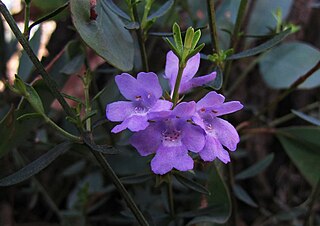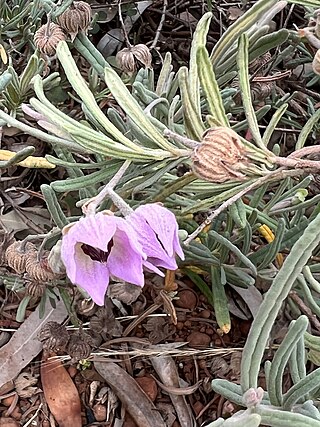
Banksia mucronulata, commonly known as swordfish dryandra, is a species of shrub that is endemic to Western Australia. It has spreading, hairy stems, linear, deeply pinnatifid leaves with sharply-pointed lobes, pale yellow to cream-coloured flowers in heads of between 80 and 180, and egg-shaped follicles.
Westringia cremnophila, commonly known as Snowy River westringia, is a flowering plant in the family Lamiaceae, a rare shrub that is endemic to Victoria, Australia. It is a small shrub with leaves mostly in groups of three and white flowers.

Westringia crassifolia, commonly known as whipstick westringia, is a flowering plant in the family Lamiaceae and is endemic to Victoria, Australia. It is a rare shrub with narrow leaves and lavender-purple or pink flowers in spring.

Westringia eremicola, commonly known as slender westringia or slender western rosemary, is a flowering plant in the family Lamiaceae and is endemic to eastern Australia. It is a small shrub, with narrow leaves and pink, mauve to white flowers.

Westringia dampieri, commonly known as shore westringia, is a flowering plant in the family Lamiaceae, it grows in South Australia and Western Australia. It is a small, dense shrub with white, mauve, cream or purple flowers.
Cassinia maritima commonly known as coast cassinia, is a species of flowering plant in the family Asteraceae and is endemic to coastal areas of south-eastern Australia. It is an erect shrub with glandular hairs embedded in a sticky layer on its branches and leaves, needle-shaped leaves, and white to yellowish heads of flowers arranged in a flat-topped corymb.
Cassinia monticola commonly known as mountain cassinia, is a species of flowering plant in the family Asteraceae and is endemic to mountain areas of south-eastern Australia. It is a spreading shrub with sticky, narrow linear to narrow lance-shaped leaves, and bronze-coloured to greenish-cream heads of flowers arranged in a dense, round-topped corymb.

Hakea kippistiana is a shrub in the family Proteacea and endemic to Western Australia. It is a dense prickly shrub with sharp needle-shaped leaves with fragrant white, cream or pink flowers from November to February.

Hakea polyanthema is a species of flowering plant in the family Proteacea that is endemic to Western Australia. It is a shrub with needle-shaped leaves and small groups of small unpleasantly scented flowers in leaf axils.

Grevillea coccinea is a species of flowering plant in the family Proteaceae and is endemic to the south of Western Australia. It is a low-lying or sprawling shrub with narrowly wedge-shaped to linear leaves and white, cream-coloured, and red or yellow flowers.
Homoranthus tricolor, is a flowering plant in the family Myrtaceae and is endemic to a small area in south-east Queensland. It is an upright shrub with linear to lance-shaped leaves and green, red and black flowers arranged singly or in pairs in upper leaf axils.
Cassinia nivalis commonly known as ochre cassinia, is a species of flowering plant in the family Asteraceae and is endemic to eastern Victoria, Australia. It is an erect shrub with hairy, deep reddish-purple branches, hairy, needle-shaped leaves, and cream-coloured to ochre heads of flowers arranged in a hemispherical corymb.
Cassinia tegulata commonly known as avenue cassinia, is a species of flowering plant in the family Asteraceae and is endemic to a small area near the Victoria-South Australia border. It is a small to medium-sized shrub with hairy foliage, needle-shaped leaves, and dense heads of off-white to cream-coloured flowers arranged in corymbs.

Cassinia thinicola commonly known as sand everlasting, is a species of flowering plant in the family Asteraceae and is endemic to coastal New South Wales. It is a compact shrub with hairy young stems, needle-shaped to slightly flattened leaves, and corymbs of up to 150 flower heads.

Hovea speciosa is a flowering plant in the family Fabaceae, endemic to eastern Australia. It has purple pea flowers, linear leaves with long, rusty hairs on the lower surface. It is endemic to New South Wales.

Westringia longifolia, commonly known as long-leaved westringia, is a flowering plant in the family Lamiaceae and is endemic to southeastern Australia. It is a small shrub, with linear leaves and mostly white flowers.

Westringia angustifolia, commonly known as scabrous westringia, is a flowering plant in the family Lamiaceae and is endemic to Tasmania. It is a small, upright shrub with mauve or white flowers.

Cassinia sifton, commonly known as sifton bush, is a species of flowering plant in the family Asteraceae and is endemic to south-eastern continental Australia and an introduced species in other places. It is a multi-stemmed shrub with linear leaves, and more or less conical heads of 50 to 200 deep red to pale brown flowers. It is sometimes confused with Cassinia arcuata and authorities differ on its distribution.

Commersonia apella, commonly known as many-flowered commersonia, is a small, upright shrub in the family Malvaceae and is endemic to Western Australia. It has hairy leaves and whitish flowers.

Guichenotia intermedia is a flowering plant in the family Malvaceae and is endemic to Western Australia. It is a small shrub with hairy leaves and mauve-pink flowers.














